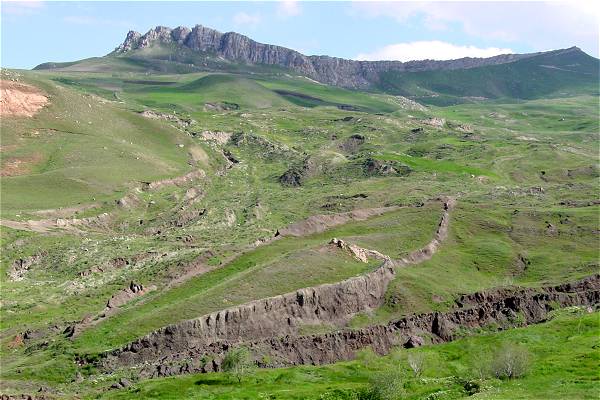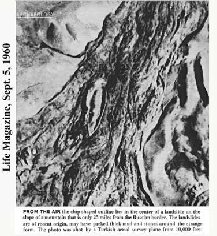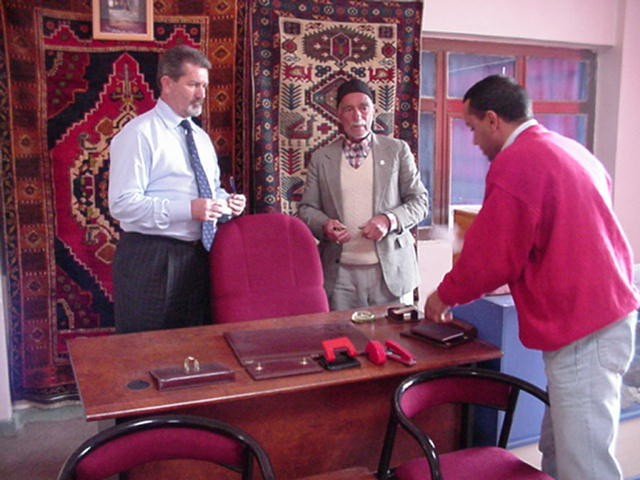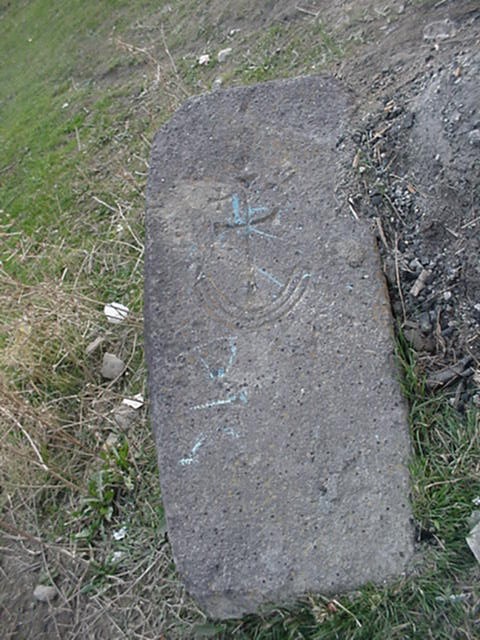|
Noah's Ark Has Been Found!
In fact you can drive right up to the
Ark
and take pictures of it! Can you see the clear outline of the Ark in
the below picture? Only the clear outline of the petrified ship
shows above the mudflow that captured it millennia ago.
Government
officials in Turkey have declared this to be the verifiable
archeological site of Noah's Ark, and built a road up to it for
tourists.
Controversial — Intriguing — Biblical — Historical

—very
visible and accessible—
GO TO THE PICTURE
PAGES 1
& 2
To See 10 More
Pictures with commentary
To
which someone will say:
Drive right up to Noah's Ark?
You've got to be kidding!
I thought it was locked in ice in some remote, unknown, craggy ravine
high up on Mt. Ararat.
Many
people would say that sounds ridiculous, but the government of turkey
has had their own archeologist study the site, and they have
officially declared this to be the authentic Ark spoken of in the book
of Genesis! And the
Koran (Qur'an),
as well as the Bible and
Pentateuch, contains this book.
To
even bring up the subject is to instantly raise a controversy, because
there have been so many false reports and folk legends told about it. Yet, just is
there is counterfeit money, there is also the real thing. This is a
well-known site with a very visible Ark to study, but at the same time
we want to bring in well-credentialed scientists to study the site and
confirm whether or not this is Noah’s Ark. Let me tell you about the
long history of this ancient site, and what our plans are.
The Long History of This Site
According to Ussher, the Genesis flood occurred in 2,348 B.C., making
the Ark almost 4,500 years old, IF it still exists. The only way a
wooden structure such as the Ark could still be in existence today is
for the wood to become petrified before rotting into dust. And that is
a possibility.
The
fact that the Ark sits in a mudflow at 6,300 feet above sea level
gives us a clue. Some scientists think it has been sliding in this
mudflow from the crest of the mountain for centuries. It is argued
that this mud was once volcanic ash and lava that was spewed there by
a local volcano. Over the centuries volcanic ash and lava breaks down
into rich, fertile soil. The ash and lava would have sealed the wood
very rapidly so that no oxygen could cause the wood to decay.
Or
the Ark could have landed in this spot after the ash and lava had
turned into soil, and within a short time become buried when an
earthquake caused a mudslide. Then water would have had to flow
through the wood so that minerals could replace the wood, cell by
cell. Little is known about how petrification takes place, but there
is reason to believe that what we are calling “Noah’s Ark” is indeed
petrified wood. And Wyatt said there is petrified wood lying all over
the landscape.
Why Did God Save The Ark For This
Time In History?
One thing
is clear. If this is Noah’s Ark, then God very deliberately fossilized
it for His divine purposes. Now, all we have to do is figure out what that purpose is.
Perhaps He preserved the Ark to bring it to the attention to the world
at this time in history to emphasize the prophetic age we are now in.
Christians already believe God and His Bible by faith, so finding
Noah’s Ark is not needed to build our faith. So,
God is not doing this to boaster the faith of
Christians, He is doing it for His glory and as a sign to this
generation.
Proving
this is Noah's Ark will do serious damage to evolutionists and
theological minimalists who do not believe the flood happened and that there was
an Ark. The historicity of Noah and the flood will show that God’s
involvement with mankind and his history is undeniable…whether anyone
repents or not. And
prophecy says that the end times would be like it was in the time of
Noah. So the revelation of the Ark may well be a symbol of the
fulfillment of that prophecy.
The Location Of The Ark
The
location of the Ark is called "the Durupinar site," named after the
Turkish army captain that first spotted the ark in an aerial photo in
1959 while routinely examining aerial photos of his country. His
report resulted in the first expedition to the site.

Yet some
people refer to this find as “the Wyatt site;” named after Ron Wyatt, the
well known amateur archeologist who brought notoriety to the site.
|

Ron Wyatt made a
model of the Ark and tested it in turbulent waters to prove its
stability. Replicas of anchor stones were once suspended from
its sides, not shown in the picture. |
Today
the Ark rests on the side of mount Cudi Dagi that faces Mt. Ararat.
This site on Cudi Dagi is a mere 20 miles away from Mt. Ararat and
just 1 mile from the Iran border. The view of Mt. Ararat is glorious
from the Ark.
In
reference to "Judi" (the Turkish word for Cudi) the Sura Hood of the
Koran says that "the affair was finished and the ark rested on
al-Judi." Is it mere coincidence that the Ark-mountain opposite
Ararat, is called Judi?
Pilgrimages
To The Ark In Ancient Times
Some
history sources indicate that pilgrimages were made to the Ark for
centuries until a mudslide buried it, causing the location to be lost
until 1959 when another
mudslide cleared the site again.
For
instance, Flavius Josephus , c. 90 AD, the famous Jewish historian
quotes Nicolaus of Damascus who wrote that the remains of the wood of
the ark were preserved for "a great while." In another place he
states that "remains of that ark, wherein it is related that Noah
escaped the deluge...are still shown to such as are desirous to see
them."
Josephus quotes Berosus the Chaldean Priest, c.290 BC, who wrote: "It
is said there is still some part of this ship in Armenia (another name
for Ararat)...and that some people carry off pieces of the bitumen,
which they take away, and use chiefly as amulets for the averting of
mischiefs."
Statements such as these, of course, could have been based on mere
rumor. Nevertheless, they do show that all of these men envisioned the
ark as coming to rest on a spot that was accessible. And even if
true, that still does not prove that the site they made pilgrimages to
was what is now known as “the Wyatt’s site.” Again, that is why more
tests are needed.
The Mountains In The Nation of Ararat
|
"And the Ark rested in
the seventh month, on the seventeenth day of the month, upon the
mountains of Ararat. |
|
And the waters
decreased continually until the tenth month: in the tenth month,
on the first day of the month, were the tops of the mountains
seen."
...Genesis 8:4-5 |
It is
almost shocking to discover that the Bible does not say the ark rested
on Mount Ararat!
The Genesis account says the ark came to rest in
the hary Urartu, or the "mountains of Urartu," and a single mountain is
not named.
This
is what the Bible actually says: "And the ark rested...upon the
mountains of Ararat" (Gen 8:4). "Ararat" was the name of a
country or region. Jeremiah called it the "Kingdom of Ararat" (Jeremiah
51:27).
The
word Ararat is but the Hebrew form of the Assyrian Urartu.
In the late 7th century this general area became known as Armenia.
After King Sennacherib was assassinated by his two sons, they fled
from Nineveh to "Armenia" (2 Kings 19:37).
The
term "Ararat" and "Armenia" are both translated from the same
Hebrew word in the Bible (Strong's Concordance, 780), Ararat
simply being the older word by which that country was known.
Today the Turkish name for Mt. Ararat is Agri Dagi (painful mountain)
because it is a
classic volcano which last erupted in the mid-1800s. There is the
possibility that the mountain was not even a mountain (at least to
15,000 feet altitude) at the flood's end.
Our Plans to Excavate the Ark
We are in
the process of applying for a visa from the Turkish government to take
a team of archeologists and geologists to study
the site. They will be using state of the art equipment to determine
if this is or is not an ancient boat. If it is, then it has to be
Noah's Ark because there can be no other explanation for a 515 ft
vessel being on a mountain side over 100 miles from a body of water.
It has
been suggested that perhaps this ship is an Egyptian merchant ship that sunk
during the deluge. But history tells us that ship builders could
not build a ship over 250 long
4300 years ago.
For there to be even one
ship that long
had to be something God personally designed.
This mission will make world history and will be
talked about for decades!
|
This is an
inside view of the tourist shop built by the Turkish government
just a few hundred feet from the Ark. It contains a museum and a
snack shop for tourists that come during the months the weather
permits.
CLICK HERE
to go to the Noah's Ark Museum site. |
 |

The Tourist Shop
Pictured here is the old
man that runs the shop (in the middle) and our guide (in the red
shirt). |
My
team
called me
from the Wyatt Site in Turkey on Oct. 28, 04. They were there to take
pictures and video and to get a feel of the place. The above and
below pictures were taken then. Click here to see more of their pictures.

Note the Ark engraving on the stone
So far
all observations and testing has been done by competent,
devoted
amateurs. Even though the government of Turkey sent one of their
archeologists with Wyatt when he did his testing over a decade ago,
scientists do not recognizing their findings because Wyatt was an
amateur. That is why we are determined to send in a team of
scientists that universities and the news media, and Biblical
Archeological Review Magazine recognize as qualified professionals.
Radar scans reported by the Wyatt team show a regular pattern of
timbers inside the ark formation, revealing keels, keelsons, gunnels,
bulkheads, animal chambers, ramp system, door in right front, two
large barrels in front 14 x 24', and an open center area for air flow
to all three levels.
Academic—neutral—open minded
We
are not doing this to prove that this IS the Ark, nor are we
involved to prove that this ISN'T the Ark. We will conduct
ourselves in an academic manner. That means we will also require the
scientists to be neutral, and we will stipulate that more than one
blind test be run so as to confirm or contradict other tests.
If our
initial test shows that this really is the ark, our team will apply
for a work pass that will allow us to make a small test excavation (up
to 10 x 10 x10 ft at the bow) to see how feasible a full scale
excavation will be.
If our
team and the Turkey government are still interested, then an
excavation of as much of the interior of the ark as is practical will
proceed.
We cannot guarantee that we will get the clearance and finances
needed to fulfill these plans, but rest assured we are using all of
our resources to do so. And we cannot guarantee that this is indeed
Noah’s Ark. But even if it is not, we will have made a major
contribution to science, and Ark seekers will know to look elsewhere.
To
make arrangements for our team to make a presentation for you, or to
make a contribution to this project, or to ask questions or make
comments, contact us at:
july1229@cox-internet.com
.
.
GO TO THE PICTURE
PAGES 1
& 2
To See 10 More
Pictures with commentary
Contributions are tax
deductible through:
Mission Service Ministries
16261 Pin Oak Rd.
Fayetteville, Ark. 72704
(479) 443-2135

A BRIEF HISTORY
1. The Bible says the Ark landed on the 'mountains' of Ararat, not on
'Mt. Ararat (Gen. 8:4).
2. The ancient Armenians never identified Mt. Ararat (which they called
Mt. Masis) with the Urartu region where the Ark landed.
3. The Chaldean version of the Bible uses Mount Kardu (or better,
mountains of Kardu) in place of Ararat. Mountains of Kardu/Kardum is
identical with Gordyeaen Mountains in Greek which Berosus (275 BC)
identified with the Ark location.
4. The Gilgamesh Epic (650 BC) states Mt. Nisir as the landing place of
the Ark. The annals of Ashurnasurpal II of Assyria (833-859 BC) places
it south of the Zab river
5. Theophilus of Antioch (115-185 AD) said the Ark could be seen in his
day in the Arabian mountains. Later Church Fathers also mention the Ark
as late as the mid 7th century.
6. The Koran of the Moslems (7th cent.) places the Ark on Al Judi, a
mountain in the country of Masur. Judi is believed to be a form of
Gordea or Kurd.
7. It was in the 13th century that Willam, a traveler, stated for the
first time that Mt. Masis was the Ark location (present-day Mt. Ararat).
8. Ptolemy's Geographia (1548) mentions the mountains of Armenia as the
place of landing. So does the traveler Nicolas de Nicolay (1558). Both
state that Mt. Ararat is equivalent to Mount Gordian, a mistaken
identification.
Bibliography
1. Noah's Ark: Fact or Fable? by Violet Cummings
(Creation-Science Research Center, San Diego, 1972)
2. The Ark File by Rene Noorbergen (Pacific Press Publishing
Association, 1974)
3. The Quest for Noah's Ark by John Warwick Montgomery (Pyramid Book,
1974)
4. In Search of Noah's Ark by Dave Balsiger and Charles E. Sellier Jr.
(Sun Classic Books, 1976)
5. The Lost Ship of Noah by Charles Berlitz (Fawcett Crest, New York,
1987)
6. The Ark of Noah by David Fasold (Wynwood Press, New York, 1988)
7. Discovered: Noah's Ark by Ron Wyatt (World Bible Society, 1989)
Other Sources:
Discovered! Newsletters of Wyatt Archaeological Research (W.A.R.)
September 1992 to Present
Discovered! Noah's Ark video by W.A.R.
Surprising Discoveries video by Jonathan Gray (available from the
Anchorstone web site)
Recommended for further
reading:
www.wyattmuseum.com
http://www.geocities.com/CapeCanaveral/Lab/8223/Noah-s_Ark.html
http://origins.swau.edu/papers/global/noah/default.html
http://www.noahsarksearch.com/davedeal.htm
www.pinkoski.com
www.arkdiscovery.com
http://www.arkdiscovery.com/noah's_ark.htm
www.anchorstone.com/wyatt
Contributions are tax
deductible through:
Mission Service Ministries
16261 Pin Oak Rd.
Fayetteville, Ark. 72704
(479) 443-2135
|





